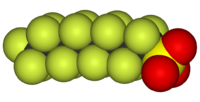
Photo from wikipedia
Rationale The ability to perform absolute quantitation and non‐targeted analysis on a single mass spectrometry instrument would be advantageous to many researchers studying per‐ and polyfluoroalkyl substances (PFAS). High‐resolution accurate… Click to show full abstract
Rationale The ability to perform absolute quantitation and non‐targeted analysis on a single mass spectrometry instrument would be advantageous to many researchers studying per‐ and polyfluoroalkyl substances (PFAS). High‐resolution accurate mass (HRAM) instrumentation (typically deployed for non‐targeted work) carries several advantages over traditional triple quadrupole workflows when performing absolute quantitation. Processing this data using a vendor‐neutral software would promote collaboration for these environmental studies. Methods LC‐MS (Orbitrap Exploris 240) was used for absolute quantitation of 45 PFAS using precursor (MS1) peak areas for quantitation, whereas isotope pattern matching and fragmentation (MS2) pattern matching were used for qualitative identification. In addition, a fluorinated chromatographic column achieved superior separation compared to the typical C18 columns typically used in PFAS analyses. This method was validated across eight different chemical classes using recommended guidelines found in EPA Method 537.1 and Skyline data processing software. Results The validated limits of all 45 compounds, as well as metrics or accuracy and reproducibility, are reported. Most compounds achieved limits of quantitation in the range of 2‐50 ng/L. Four newly released Chemours‐specific compounds (PEPA, PFO3OA, PFO4DA, and PFO5DoA) were also validated. Aspects of data analysis specific to high resolving power absolute quantitation are reviewed as are the details of processing these data via Skyline. Conclusions This method shows the feasibility of performing reproducible absolute quantitation of PFAS on an HRAM platform and does so using an open‐source vendor‐neutral data processing software to facilitate sharing of data across labs and institutions.
Journal Title: Rapid Communications in Mass Spectrometry
Year Published: 2022
Link to full text (if available)
Share on Social Media: Sign Up to like & get
recommendations!